Reader's Choice
Popular articles
Any person is familiar with such an unpleasant phenomenon as ulcers, sometimes appearing on the tongue. They can be caused by specific diseases of the oral mucosa, common diseases and microtraumas of the tongue. These ulcers cause pain when eating and cause general discomfort in everyday life.
Ulceration on the mucous membrane of the tongue can be caused by various reasons, but the main ones are three:

Also known as benign migrating glossitis, geographic language is a safe condition affecting the surface of the tongue. In this condition, the tongue is usually covered with tiny, pinkish or white bumps. Lesions or stains in a language give the language a geographical appearance or a geographical appearance, thus the geographical language of names. Although the condition may seem disturbing, it does not cause health problems and it is also not associated with infection or cancer.
Specific diseases of the oral cavity - simple, herpes or aphthous stomatitis, necrotizing periadenitis (Setton aphtosis) and a purely childhood disease - Bednar's aphtosis;
Common diseases that contribute to the formation of ulcers include various allergic syndromes, viral infections, syphilis, tuberculosis, HIV infection;
Traumatic ulcers on the tongue appear as a result of thermal and chemical burns, the use of a hard-toothed toothbrush, occasional bite of the tongue, injury by sharp chipping of the teeth.
There are many conditions that can lead to abnormalities, such as bumps, ulcers, or tongue ulcers. These abnormalities are responsible for symptoms such as pain, swelling and burning. Swelling or inflammation of the tongue can be the result of an infection, a tumor, a chronic illness, injury or toxins.
Ulcers or inflammations can occur on the sides of the tongue, the tip of the tongue, on the back of the tongue or all along the tongue in some people. Given that pain can be the result of many different reasons, the best way to treat a sore that appears on the tongue will be to consider the root cause.
Before choosing a method of treating ulcers, it is necessary to determine the cause of their occurrence. Moreover, the choice of drugs also depends on the etiology of the disease. Herpes infections are suppressed by drugs that destroy the herpes virus. Candida stomatitis is treated with antifungal drugs.
Other conditions that may be associated with soreness include dehydration, dry mouth and fever. Another most likely cause of pain under the tongue is oral thrush. Oral thrush is also known as oral candidiasis, a yeast or fungal infection that develops on the mucous membranes of the mouth.
In adults, acute thrush usually manifests itself as thick, white or creamy deposits on the mucous membrane - a thin lining of the mouth, tongue and throat. This lining will look puffy and slightly red. Spots on the tongue will be raised, causing discomfort and burning. Oral thrush can be the reason that you have a pain under your tongue.
Today, there are generally accepted procedures that should be performed when the appearance of sores of any origin in the language. This is primarily:
Take a multivitamin;
The use of low-salt and subtle diets;
Rinsing the mouth with antiseptic solutions;
Local cauterization of ulcers with antiseptic and anti-inflammatory drugs.
Metal braces and curved prostheses can cause pain on the sides of your tongue. Ulcers ulcers in the mouth and tongue can cause great pain. Ulcers ulcers are small ulcers that develop inside the mouth. Diseases can also develop at the base of the gums, inside the cheeks and palate of the mouth, lips and sometimes on the tongue.
These ulcers are usually painted white or yellowish, surrounded by a slightly swollen red area. These sores are benign and, as such, will not lead to a more serious oral problem. Basically, like fever blisters, they are a common viral infection. Just like canker sores, these are tiny, fluid-filled blisters on and around the lips. Cold ulcers are caused by the herpes simplex virus, which is closely related to that which is known to cause genital herpes.
Rinsing the mouth can be carried out with solutions of baking soda, potassium permanganate, furatsilina. For local cauterization using brilliant green, hydrogen peroxide. From pharmaceutical pharmaceuticals, dentists recommend:
Lidocaine gels and sprays;
Ointments and gels with dexamethasone;
Chlorhexidine solution for rinsing;
Aphthous ulcers Ulcers Swollen glands under tongue Oral lichen Planche Injury or infection Oral herpes Oral cancer Food or drug allergies that cause swelling of the tongue Vitamin deficiency and anemia Burning mouth syndrome Excessive dehydration in the mouth. Acute pain on the sides of the tongue can be a source of discomfort. Pain can make you difficult to talk or swallow. What then is the possible cause of the sharp pain and what do you need to do to get rid of the pain?
Most people with pain on the sides of the tongue also develop ulcers and ulcers in the tongue. Ulcers or vesicles can be red or yellow and in most cases fill with liquid, this is a common case for herpes or fever. Another possible cause of severe pain may include the following.
Various forms of drugs with cholesal.
Excellent agents that have anti-inflammatory, antiseptic and healing effects are decoctions and tinctures of herbs - calendula, pharmacy chamomile, sage, thyme, oak bark.
To successfully treat ulcers, start rinsing, cauterization, taking the recommended medication should be started as soon as possible - optimally immediately after the first signs of the disease appear.
The most common cause of pain is a viral infection. Viral infection of the mouth or tongue may be the same for those that affect the hands, feet. A good example is the cold sore. Cold sores, sometimes called fever blisters, are a small blister that develops on the lips and around the mouth. Cold ulcers are caused by the herpes simplex virus and are usually cleared without treatment.
The symptoms of a herpes infection or any other viral infection of the tongue will vary depending on how severe the infection is. In most cases, the symptoms can range from small white spots, mild tingling to painful large blisters around the tongue. Although the infection can cure itself, it is important to seek early treatment from your dentist.
The language is one of the five human senses, permeated with a large number of blood vessels and is responsible for determining the taste of food. It is the most flexible and mobile muscular organ located in the oral cavity. The position and shape of the language varies depending on the function performed. At rest, it has a spade shape.
Most viral infections in the mouth can be treated with antiviral drugs. This drug therapy allows you to control the infection and accelerate healing. Ulcers can be another possible cause of pain under your tongue. The difference between ulcers of the ulcer and herpes is that, unlike cold ulcers, they are not found on the surface of your lips. Bowel diseases are also not contagious.
They can, however, be painful, causing a lot of discomfort and difficulty in talking and eating. Most cases of these sores go away on their own within a week or two. For those who do not, you will need to contact you, a doctor or a dentist. You will also need to see a doctor if you have large or painful sores or when the ulcers do not heal.
Purulent ulcer on the side of the tongue gives pain and discomfort
The human language is most actively involved in the processes occurring in the body, helping with the ingestion and absorption of food, performing a fundamental role in the formation of speech, taste perception and the formation of saliva. Thanks to him, an infant can suck mother's milk.
The actual cause of ulcers is not known, but it is believed to work in families and can be caused by things like stress, the menstrual cycle, trauma and injuries in your language, food allergies or eating and eating large amounts of acidic foods such as oranges. .
Pain can also mean that you have an iron deficiency that is known to cause anemia. This vitamin has an important function in the body, such as maintaining a healthy nervous system. This flaw can cause a wide range of problems. Some of the symptoms will include.
The structural features of the most sensitive muscle of the body allow a person to perceive bitter, sour, sweet and salty, due to the presence of more than two thousand onions on its surface.
Language is an indicator of human health and is designed so that you can accurately identify, determine the condition of not only the gastrointestinal tract, but also other internal organs.
Lack of energy and excessive fatigue Painful sores and red tongue Painful mouth ulcers. Without treatment, this can lead to problems with memory, understanding and judgment. . Anemia is a condition in which iron deficiency in the body leads to a decrease in the number of red blood cells. When anemia is caused by a lack of iron, then the condition is called iron deficiency anemia.
Pain in the tongue and mouth is a common symptom of anemia. Severe headache Painful sore mouth or abnormal smooth tongue Fatigue and lack of energy Dyspnea Pale complexion Changed sense of taste Difficulties in swallowing food Painful ulcers in the corners of the mouth. If the main cause of pain under the tongue is iron deficiency anemia, then treatment will include iron supplements to increase the low levels of iron in your body. This form of treatment is usually effective. Iron deficiency anemia rarely causes long-term problems.
In a healthy person, the tongue is pink, clean, without bloom, has normal moisture and sensitivity. Any plaque, swelling and inflammation that occurs in the oral cavity indicate problems in the body.
Any kind of plaque indicates diseases: yellow - of the stomach and duodenum, red - heart, white - fungal diseases. Since ancient times, people have received information about the state of human health, exploring the surface of the organ of taste. And today, this knowledge is used to determine the first symptoms of the disease.
You can also increase your iron levels by consuming: dark green vegetables, brown rice, legumes and legumes, meat and fish, eggs, and dried fruits such as apricots, prunes, and raisins. 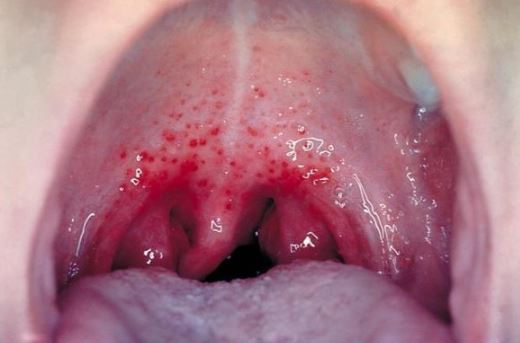
Candidiasis is a common oral infection that is known to cause oral thrush. Oral thrush infections occur when a yeast infection develops on the inside of your mouth and on the tongue.
Acute pain arising on the sides of the tongue can also be simply the result of external injuries and traumas. For example, you can bite your tongue to develop painful sores on the sides of the tongue that can last a long time. You can also develop sore nipples or taste buds as a result of injuries to the tongue. These are painful blows, usually from a bite or injury. Buds may also swell as a result of irritation from hot products.
Most sores heal quickly, cure easily and do not pose a serious health hazard, but sometimes can indicate the presence of severe ailments of the oral cavity and various internal organs. Therefore, even if these inflammations do not bother you, you can not leave them unattended and clean up sooner.
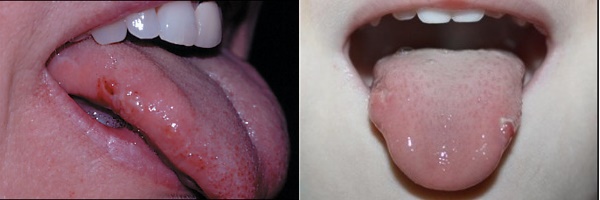
Oral lichen is a chronic inflammation of the skin in the mouth. Although this is a normal adult over the age of 45, the condition can affect young adults and children, and this is a possible cause of pain in the mouth and tongue. The discomfort caused by pain under the tongue can be very annoying. Although pain may not be a cause for concern from time to time, understanding the root cause may be important in getting rid of pain, irritation and inflammation in the mouth.
However, it is important that the dentist investigates the symptoms in order to establish the root cause of the pain. Thus, effective treatment can be prescribed to get rid of pain and prevent recurrence in the future. Treatment can vary from person to person, depending on the underlying cause, the patient’s general health, the history of the condition, and how strong the immune system is. Some cases of pain may disappear without treatment, but to quickly get rid of the pain, you will need to do the following.
Biting the tongue - painful injuries
Oral mucosa is constantly exposed to irritating external factors. But thanks to the ability of the salivary glands to reduce the permeability of viruses and bacteria and to neutralize the acid formed during the meal, in a healthy state, the body does not respond to them by any external formations on the tongue. In the oral mucosa is constantly present a certain number of pathogens.
Make sure you brush your mouth or wipe your mouth every day so that it does not contain the bacteria that cause the infection. You can also rinse your mouth with antibacterial mouthwash, so you can gently clean your mouth while reducing irritation. For a condition such as candidiasis that can cause pain under the tongue, the American Academy of Oral and Maxillofacial Pathology. Most dentists or doctors recommend antifungal treatment of candidiasis. The drug can be either in the form of lozenges or mouthwash for mild cases or oral pills for a more serious condition. For injuries and injuries that cause pain under the tongue, you need to avoid food that causes such damage, and those that can worsen the pain. Drink plenty of water and other fluids to moisturize your mouth, so you can reduce pain and irritation in the mouth and under the tongue.
With a decrease in immunity, the body can not cope with pathogens and responds to changes in various types of inflammation, causing discomfort, itching, pain, complicating the process of eating, violating diction. But thanks to the good absorption capacity, the medicine that enters the mouth quickly enters the bloodstream.

Candida plaque on the sides of the tongue
The location, nature and color of the sore can “tell” about the sources of the disease. Some time after the bacteria gets on the wound formed on the surface of the tongue, a white pimple or bump may appear. The location of the pink, white or reddish ulcers close to the throat or side of the taste analyzer is a consequence of the fact that you have stomatitis - a disease that affects the oral mucosa.

Herpes rash on tongue
White rash and plaque are formed with the development of stomatitis and candida. Light pink and red ulcers are observed with burns of different parts of the taste analyzer, allergic reactions, herpes. With subcutaneous hemorrhages, vascular lesions and injuries of the surface of the organ of taste, even black rashes are observed.
An ulcer can appear in the tongue, less often on the palate and gums. Such an education people call pimple, because it is very similar to them. But this name is not entirely true due to the lack of sebaceous glands in the tongue.
Many people do not know what to do if there is a sore on the tongue. To eliminate the disease you need to know the causes and treatment. And only after finding out the cause of the appearance of inflammatory formations, it is necessary to choose the most effective means to remove, cure and prevent their reappearance.
Frequent reasons include:

Desquamative stomatitis in the tongue
The choice of treatment for sores depends on the nature and cause of its occurrence. If the herpes virus is present in the body, it is necessary to consult a doctor, since in the absence of specific treatment this virus can affect the internal organs of a person.
Relief of pain and itching can be with the help of traditional medicine and solutions of iodine, salt or soda. They can be used in conjunction with a treatment or prior to a doctor's appointment. Broths, infusions, oils obtained from flowers, leaves, buds and other parts of plants have healing antiseptic and healing properties.
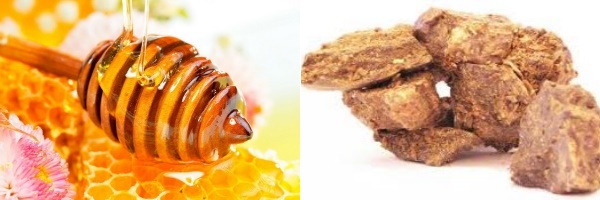
Honey and propolis - folk remedy
As an antiseptic, use the fruits of viburnum, decoctions and lotions of herbs St. John's wort, yarrow, chamomile or sage. Thanks to the healing properties of calendula, aloe juice, rosehip oil and sea buckthorn, these tools are widely used for disinfecting the oral cavity.
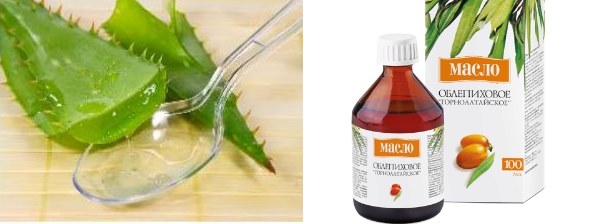
Aloe juice and sea buckthorn oil are used for applications.
In the treatment of diseases of the oral cavity using the healing properties of oak bark, propolis, honey, onions, flowers, tea rose.
According to the effectiveness of the actions of the national methods can not be compared with the treatment of medicines, as well as the elimination of the source of the disease. But in complex therapy with medicines prescribed by the doctor, the healing process is accelerated.
Pharmacies on the shelves have a huge amount of tools to help get rid of inflammation in the language. Most of them are sold without a prescription and are available for anyone who wants to cope with this problem.

Chlorhexidine and Miramistin - antiseptics
Depending on the causes and pathogens that cause ulcers in the tongue, antiseptic, antibacterial, antiviral or anti-inflammatory drugs are used. These medicines are of local, direct and general action. It must be remembered that the use of drugs without an appointment is not recommended.
Self-medication is dangerous in that the choice of the wrong remedy or its incorrect dosage will lead to an acute allergic reaction, as well as aggravate the problems that already exist. Therefore, before using the medicine, it is necessary to consult a doctor for consultation.
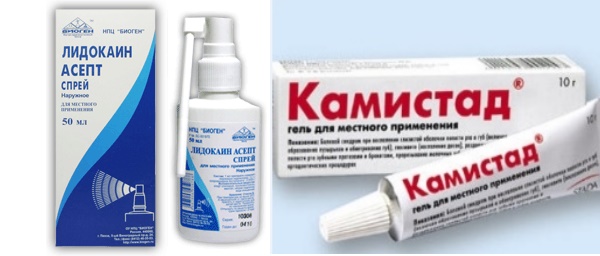
Kamistad and Lidocaine apply. to relieve pain
When an ulcer appears in a language of bacterial origin, antibacterial drugs of general or local action are used. Antibacterial and antiseptic drugs of local action include rinsing solutions, sprays and lozenges for sucking. Antibiotics are common antibacterial and general antiviral agents.

Anti-inflammatory drugs prescribed by a doctor
The recovery of the patient depends on many factors: correct diagnosis, competence of the doctor, well-chosen medicines, patient following the doctor’s recommendations, and oral hygiene. Competent brushing of the teeth twice a day and rinsing the mouth after eating will help prevent the multiplication of pathogens and their entry into wounds and cracks, as well as the appearance of ulcers, pustules, boils.

Antiviral drugs used for herpes
Pathogenic bacteria enter the human body through thermally unprocessed foods, unwashed vegetables and fruits and settle on the hands.
Therefore, washing your hands after walking outdoors, visiting the toilet and before each meal and eating only washed vegetables and fruits and thermally processed foods should become the norm.
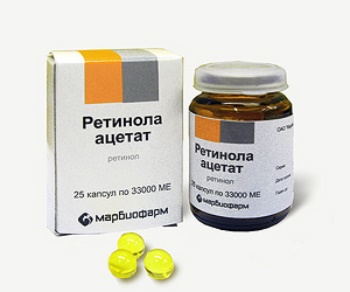
Vitamin A - an effective tool in the treatment of language
In order to avoid lesions on the tongue, it is necessary to refuse or reduce the effect of allergens and irritants, such as spicy, sour and hot foods, alcohol, cigarettes, cosmetics, carbonated drinks, and contrasting temperatures.
| Related articles: | |
|
Ulcers in the tongue: why arise and how to treat them?
Anyone is familiar with such an unpleasant phenomenon as ulcers, sometimes ... Actual ways how to transfer money from pay to pay
It is hard to imagine the life of a modern person without a phone, ... The ceiling of plasterboard do it yourself
Frankly, not all customers set a goal to turn ... | |